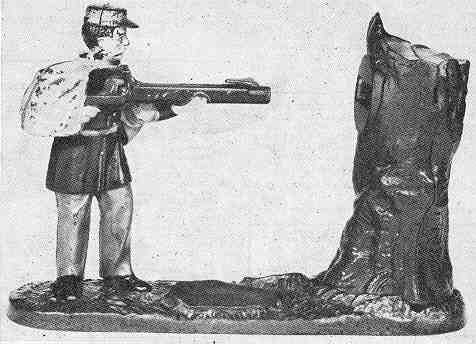Grenadier Bank, Volunteer Bank
by F.H. Griffith - HOBBIES Magazine - December, 1962

Classifying two mechanical banks in the same article is a complete departure from all previous articles since their inception. Since, however, both the Grenadier, No. 108 in the numerical classification, and Volunteer, No. 109, are so much alike, each made in England, and each a direct copy of our Creedmore Bank, they lend themselves very well to being written up together.
Before going further, let it be understood that the bank pictured is the Grenadier and not our popular Creedmore. The writer is being specific about this since there have been numerous occasions whereby Creedmore Banks have been mistaken for either the Volunteer or Grenadier. This was further emphasized by the fact that for numbers of years there was some uncertainty about the authenticity of the Grenadier and Volunteer and some thought existed as to their being recast specimens of the Creedmore with the name altered in each case. This is not so and the Volunteer and Grenadier are authentic English mechanical banks, although they were copied from our Creedmore.
The Grenadier Bank pictured is from the collection of Leon Perelman and he obtained it from an antique dealer who had purchased the bank in England. It is in very nice condition and painted as follows: The base has a grass-like surface in green, the tree trunk is brown with a yellow top and white target section. The soldier has gray trousers, black coat with yellow belt, and a red cape. His hat is red with a yellow band and he has flesh color face and hands.
To operate the bank the coin firing mechanism is set in place by pushing back on the small wedge-shaped piece on top of the gun barrel. In so doing this causes the head of the figure to tilt forward as though taking aim. A coin is then placed on the barrel and the right foot of the figure is depressed. This triggers the mechanism and the coin is fired into the tree striking a bell therein. The head, at the same time, returns to the position as shown in the picture. To further add to the action a powder cap can be inserted in the provided section of the gun, and this is fired as the coin goes into the tree.
Please note the hat on the specimen pictured. This is similar to our Creedmore, which, however, does not have the peak. The Grenadier was also made with a different type hat. This type, which is the one the writer has, is about twice as high and has a very small peak. The name "Grenadier" appears inscribed on the base plate in either case, and other than the hat the banks are identical.
The Volunteer Bank is painted similarly to the Grenadier and operates in the same fashion. All known Volunteer Banks, however, have a hat just like our Creedmore, with no peak.
Neither the Grenadier or Volunteer have a date shown on the bank, only the name in each case. It is known, however, from old English catalogs in the writer’s possession that they were made in the period of the 1890’s. It is interesting to note that the original illustrations of the Grenadier show the bank with the higher type hat and small peak.
The name Grenadier has some significance. In England in the mid 17th century a special group of powerful soldiers with exceptional physiques was formed as a military employment within the companies. This special group of soldiers, termed the Grenades, consisted of individuals known as Grenadiers. They wore a distinctive type uniform and a mitre shaped hat which was more appropriate to throwing grenades. The Grenadiers were mainly used in siege and trench warfare. After the 18th century they were retained as storm troops. In the British Army the Grenadiers were a special task force until around 1850, then in World War I they were trained in the firing of rifles as well as throwing grenades. After this war they disappeared as a unit as all infantry-men were trained to throw grenades and so on. In general the terminology "Grenadier" has always referred to a member of a special regiment or corps, as example, a Grenadier of Napoleon’s Guard.
The name Volunteer also has some significance. The term "Volunteer" originated in England around 1757 and its usage was in general reference to soldiers who were not professionals or not permanently under arms. They were put in and out of service over the years. In 1863 a new act was passed whereby all volunteers were to be immediately reorganized upon any possibility of an expected invasion. There were several occasions of reorganization and one of the last was in 1907 and 1908. This marked one of the last reorganizations under the name of Volunteers. They are now called the Territorials or the Territorial Army.
In conclusion, there is no question but that the Volunteer and Grenadier Banks were copied from our Creedmore, whose original date of manufacture is considerably earlier than either of the two English banks. However, while very much alike, there are differences in the castings, particularly on the tree section, the hats, and so on. Generally, appearance-wise, they are very similar, operate the same, and are even painted similarly. Some, however, have red coats with black capes, but this is of no particular significance.
